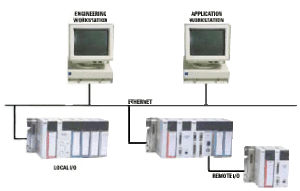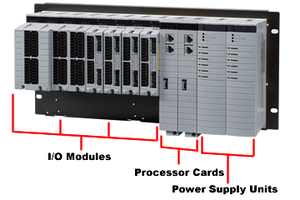Difference between revisions of "Process Control Systems PCS"
(Created page with "Category:Control Systems{{Knoppen}} <noinclude><!------------------------------------------------ * READ THIS FIRST * Only edit this page if you can improve the content. * ...") |
|||
| Line 7: | Line 7: | ||
* Please start editing this page after the /noinclude | * Please start editing this page after the /noinclude | ||
* -------------------------------------------------></noinclude> | * -------------------------------------------------></noinclude> | ||
[[File:Process control system.gif|thumb|right|Process Control Systems PCS]] | |||
[[File:Process control system1.png|thumb|right|Process Control Systems PCS]] | |||
'''Process Control System''' is a statistics and engineering discipline that deals with architectures, mechanisms and algorithms for maintaining the output of a specific process within a desired range. | |||
Process control system is extensively used in industry and enables mass production of continuous processes such as oil refining, paper manufacturing, chemicals, power plants and many other industries. Process control system enables automation, with which a small staff of operating personnel can operate a complex process from a central control room.For example, heating up the temperature in a room is a process that has the specific, desired outcome to reach and maintain a defined temperature, kept constant over time. Here, the temperature is the | |||
controlled variable. At the same time, it is the input variable since it is measured by a thermometer and used to decide whether to heat or not to heat. The desired temperature is the setpoint. The state of the heater is called the manipulated variablesince it is subject to control actions. | |||
A commonly used control device called [[PLC Controllers]], is used to read a set of digital and analog inputs, apply a set of logic statements, and generate a set of analog and digital outputs. Using the example in the previous paragraph, the room temperature would be an input to the PLC. The logical statements would compare the setpoint to the input temperature and determine whether more or less heating was necessary to keep the temperature constant. A PLC output would then either open or close the hot water valve, an incremental amount, depending on whether more or less hot water was needed. Larger more complex systems can be controlled by a [[Distributed Control Systems DCS]] or SCADA system. | |||
==Types of control systems== | |||
In practice, process control systems can be characterized as one or more of the following forms: | |||
===Discrete=== | |||
Found in many manufacturing, motion and packaging applications. Robotic assembly, such as that found in automotive production, can be characterized as discrete process control. Most discrete manufacturing involves the production of discrete pieces of product, such as metal stamping. | |||
===Batch=== | |||
Some applications require that specific quantities of raw materials be combined in specific ways for particular durations to produce an intermediate or end result. One example is the production of adhesives and glues, which normally require the mixing of raw materials in a heated vessel for a period of time to form a quantity of end product. Other important examples are the production of food, beverages and medicine. Batch processes are generally used to produce a relatively low to intermediate quantity of product per year. | |||
===Continuous=== | |||
Often, a physical system is represented through variables that are smooth and uninterrupted in time. The control of the water temperature in a heating jacket, for example, is an example of continuous process control. Some important continuous processes are the production of fuels, chemicals and plastics. Continuous processes in manufacturing are used to produce very large quantities of product per year. | |||
Applications having elements of discrete, batch and continuous process control are often called hybrid applications. | |||
Revision as of 07:46, 9 December 2012
Process Control System is a statistics and engineering discipline that deals with architectures, mechanisms and algorithms for maintaining the output of a specific process within a desired range.
Process control system is extensively used in industry and enables mass production of continuous processes such as oil refining, paper manufacturing, chemicals, power plants and many other industries. Process control system enables automation, with which a small staff of operating personnel can operate a complex process from a central control room.For example, heating up the temperature in a room is a process that has the specific, desired outcome to reach and maintain a defined temperature, kept constant over time. Here, the temperature is the controlled variable. At the same time, it is the input variable since it is measured by a thermometer and used to decide whether to heat or not to heat. The desired temperature is the setpoint. The state of the heater is called the manipulated variablesince it is subject to control actions.
A commonly used control device called PLC Controllers, is used to read a set of digital and analog inputs, apply a set of logic statements, and generate a set of analog and digital outputs. Using the example in the previous paragraph, the room temperature would be an input to the PLC. The logical statements would compare the setpoint to the input temperature and determine whether more or less heating was necessary to keep the temperature constant. A PLC output would then either open or close the hot water valve, an incremental amount, depending on whether more or less hot water was needed. Larger more complex systems can be controlled by a Distributed Control Systems DCS or SCADA system.
Types of control systems
In practice, process control systems can be characterized as one or more of the following forms:
Discrete
Found in many manufacturing, motion and packaging applications. Robotic assembly, such as that found in automotive production, can be characterized as discrete process control. Most discrete manufacturing involves the production of discrete pieces of product, such as metal stamping.
Batch
Some applications require that specific quantities of raw materials be combined in specific ways for particular durations to produce an intermediate or end result. One example is the production of adhesives and glues, which normally require the mixing of raw materials in a heated vessel for a period of time to form a quantity of end product. Other important examples are the production of food, beverages and medicine. Batch processes are generally used to produce a relatively low to intermediate quantity of product per year.
Continuous
Often, a physical system is represented through variables that are smooth and uninterrupted in time. The control of the water temperature in a heating jacket, for example, is an example of continuous process control. Some important continuous processes are the production of fuels, chemicals and plastics. Continuous processes in manufacturing are used to produce very large quantities of product per year.
Applications having elements of discrete, batch and continuous process control are often called hybrid applications.

